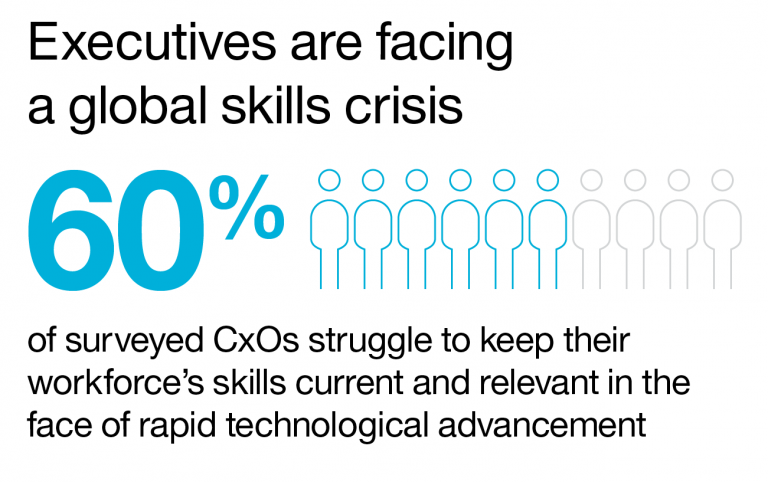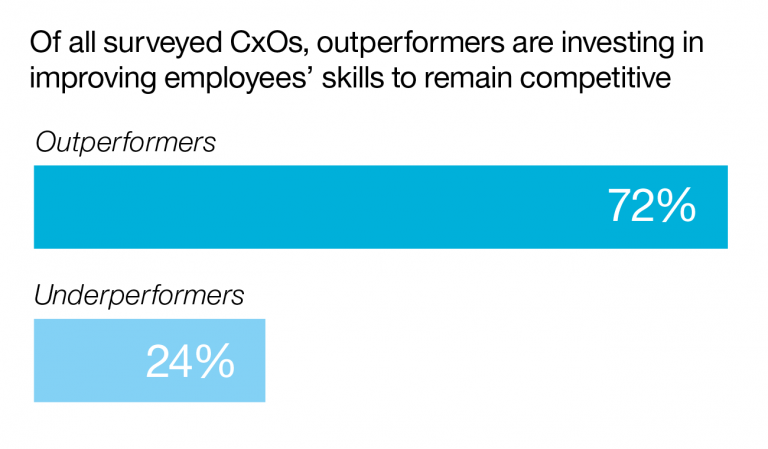From the invention of the mechanical weaving loom at the start of the Industrial Age to the debut of personal computers in the Information Age, people have typically been more hesitant than eager when faced with rapid technological change.
In retrospect, it seems laughable that society would view such transformational advances with skepticism. Technological revolution typically faces growing pains as the workforce strives to adapt its skills to the new environment. Yet it’s apparent that businesses are aiming to use these innovations as tools for human enablement rather than replacement.
Developing the latest skills poses an increasingly difficult challenge for both the C-suite and the workforce. The recent IBM Global Skills Study found that 60 percent of executives struggle to keep their workforce’s skills current and relevant in the face of rapid technological advancement. What happens when the speed of transition increases at a rate that outpaces the workforce’s ability to adapt? The outcome is a global skills gap, in which organizations are unable to sustain their human capital with the skills required to drive innovation.

In spite of the challenges and risks, some employers are willing to invest in emerging technologies and the related people skills. For example, artificial intelligence (AI) has been a hot topic this year. The IBM Institute for Business Value report, “Cognitive Catalysts: Reinventing enterprises and experiences with artificial intelligence,” indicates that the early adopters of AI are seeing business results in diverse areas such as improved talent management and retention. How are these market outperformers able to realize the benefits of this innovative technology so quickly? And in the process, what have they learned about the future of the human worker?
Bridging the skills gap
Financial analysis of the participants in the Global C-suite Study shows that top performers (those participants with above average revenue and profit growth) are nearly four times more likely to invest in AI in support of their strategic goals than underperformers. They’re also more focused on investing in their workforce to create or maintain their competitive dominance.

Outperformers are embracing the power of technology to help drive employee productivity and effectiveness today, while laying the groundwork for their human capital requirements in the future. Their organizational strategy is more likely to include reskilling or training their current workforce to be ready to adopt AI. The outperformers are farther along the path toward creating a business culture that can rapidly adapt and actualize increased productivity as the nature of work evolves. By engendering their workforce to change they may, once again, be ready to pounce on the next cycle of innovation.
Implications for the AI-enabled workforce
Opinions abound regarding the future of an AI-enabled world. Many suggest a rather dystopian future. But the executives we spoke to have a much more positive outlook. Workforce skills and availability in the next two to three years remain primary concerns for CxOs. This focus on people skills implies a desire to update or augment the workforce they have today.
Outperformers are already making their mark. They are redeploying their employees to higher value-adding tasks at three times the rate of underperformers, while deploying AI to perform more repetitive, structured work. Outperformers have discovered that the value of AI is realized when it’s used to enable workers to be more productive.
For example, employees at Woodside Energy, Australia’s largest energy company, are using AI to access 30 years’ worth of documented expertise in more than 600,000 pages of unstructured technical files. The time spent reading and searching for expert data has been reduced by 75 percent, which is helping the next generation of employees to attain the knowledge they need to become the experts of tomorrow.
The future seems anything but dystopian. Rather, top companies are putting a premium on their people and creating a pipeline of skilled human capital. By investing in their workforce today, companies are positioning themselves to take advantage of the technical innovations of tomorrow. Change can still feel uncomfortable, but technologies like AI can play a role in elevating the human workforce to meet the challenges of the future.
This blog is part of a monthly series that highlights emerging trends from our 19th Global C-suite Study. The study features interviews with more than 10,000 CxOs.
Meet the author


